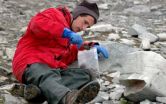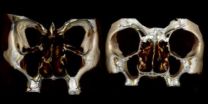(Press-News.org) Although they live in similarly extreme ecosystems at opposite ends of the world, Antarctic insects appear to employ entirely different methods at the genetic level to cope with extremely dry conditions than their counterparts that live north of the Arctic Circle, according to National Science Foundation- (NSF) funded researchers.
Writing in the Proceedings of the National Academy of Sciences, the researchers concluded, "Polar arthropods have developed distinct... mechanisms to cope with similar desiccating conditions."
The researchers noted that aside from the significance of the specific discovery about the genetics of how creatures cope in polar environments, the new finding is important because it shows how relatively new and developing scientific techniques, including genomics, are opening new scientific vistas in the Polar Regions, which were once thought to be relatively uniform and, relatively speaking, scientifically sterile environments.
"It's great to have an Antarctic animal that has entered the genomic era," said David Denlinger, a distinguished professor of entomology at Ohio State University and a co-author of the paper. "This paper, which analyzed the expression of thousands of genes in response to the desiccating environment of Antarctica, is just one example of the power that the genomic revolution offers for advancing polar science. "
The collaborative research--which included contributions from scientists at Ohio State University, the Centre National de la Recherche Scientifique (National Center for Scientific Research) in France, Catholic University of Louvain in Belgium, Stanford University, and Miami University in Ohio--was supported in part by the Division of Polar Programs in NSF's Geosciences Directorate.
Polar Programs manages the U.S. Antarctic Program, through which it coordinates all U.S. research on the southernmost continent and aboard ships in the Southern Ocean as well as providing the necessary logistical support.
The finding also adds to the developing picture of the Polar Regions as having similarities and yet subtle and perhaps very important differences, previously undetected by science. NSF-funded scientists late last year, for example, published research indicating that differing contributions of freshwater from glaciers and streams to the Arctic and Southern oceans may be responsible for the fact that the majority of microbial communities that thrive near the surface of the Polar oceans share few common members.
Although Antarctica's surrounding oceans and coastal margins are home to a variety of large creatures such as seals, penguins and whales, insect life is rare, except on the Antarctic Peninsula.
There, the Antarctic midge, Belgica antarctica, occupies its unique ecological niche.
The research team that produced the new findings collected specimens for their research from offshore islands near NSF's Palmer Station on Anvers Island in the Peninsula region.
Surrounded by an ocean, the Antarctic continent is a polar desert where creatures have adapted to life with infrequent access to liquid water. The researchers note that Antarctic midge larvae, for example, "are remarkably tolerant of dehydration, surviving losses of up to 70 percent of their body water."
They also note that, in general, "insects, in particular, are at high risk of dehydration because of their small body size and consequent high surface-area-to-volume ratio."
Among Antarctic insects, the ability to tolerate dehydration is an important evolutionary development, allowing the creatures to successful survive the cold and dry southern winter.
"The loss of water enhances acute freezing tolerance," they write. "In addition, overwintering midge larvae are capable of undergoing another distinct form of dehydration, known as cryoprotective dehydration.
Cryoprotective dehydration is a mechanism in which a gradual decrease in temperature in the presence of environmental ice "creates a vapor pressure gradient that draws water out of the body, thereby depressing the body fluid melting point and allowing larvae to remain unfrozen at subzero temperatures."
The researchers compared the midge's strategy to those of other terrestrial arthropods that cope with prolonged periods when water is lacking, including the Arctic springtail Megaphorura arctica and Folsomia candida, which are more widely distributed across the globe; both species are members of a group of arthropods, which are closely related to insects, known as Collembola.
The differences, they concluded, lie in the way that various genes express themselves.
After a detailed analysis of gene expression in the various species, the researchers concluded that "although B. antarctica and M. arctica are adapted to similar environments, our analysis indicated very little overlap in expression profiles between these two arthropods."
They add that "these differences in expression patterns may reflect different strategies for combating dehydration; whereas B. antarctica shuts down metabolic activity and waits for favorable conditions to return, F. candida [instead] relies on active water-vapor absorption to restore water balance during prolonged periods of desiccation."
They further add that because of the taxonomic difference between the Antarctic midge and the collembolan species with which gene expression was compared, more work is needed "to better understand the evolutionary physiology of dehydration tolerance in this taxonomic family."
INFORMATION:
-NSF-
Antarctic and Arctic insects use different genetic mechanisms to cope with lack of water
Genomic techniques facilitate discovery that gene expression causes disparity
2013-03-12
ELSE PRESS RELEASES FROM THIS DATE:
Low-cost nano-biosensor to detect foodborne pathogen that causes listeriosis
2013-03-12
New Rochelle, NY, March 12, 2013—The foodborne bacteria Listeria monocytogenes sickens about 2,500 people in the U.S. each year and many more worldwide, killing about 25-30% of those infected. Listeriosis is caused by eating food contaminated with L. monocytogenes, and current methods for detecting the bacteria are costly and time consuming. An innovative nanotechnology-based method for developing an inexpensive biosensor to detect the pathogen in food is described in Industrial Biotechnology, a peer-reviewed journal from Mary Ann Liebert Inc., publishers (http://www.liebertpub.com). ...
Repairing the nose after skin cancer in just one step
2013-03-12
ANN ARBOR, Mich. — The skin cancer growing on Carolyn Bohlmann's nose was not a very aggressive variety. But it was deep and located right on her nostril. The tricky part was not so much removing it – MOHS surgery, the procedure Bohlmann had, is a fairly common outpatient procedure.
The tricky part would be reconstructing her nostril so that it didn't lift up or droop down. It's an important cosmetic issue, but it's also critical for breathing.
Bohlmann opted for a new reconstruction technique her surgeon, Jeffrey Moyer, M.D., was offering at the University of Michigan ...
Cryptic clams: U-M biologists find species hiding in plain view
2013-03-12
ANN ARBOR— Cryptic comments seem to have an ambiguous, obscure or hidden meaning. In biology, cryptic species are outwardly indistinguishable groups whose differences are hidden inside their genes.
Two University of Michigan marine biologists have identified three cryptic species of tiny clams, long believed to be members of the same species, which have been hiding in plain view along the rocky shores of southern Australia for millions of years.
The unusual convergence of a climate-cooling event and the peculiarities of local geography caused the three cryptic species ...
Havoc in biology's most-used human cell line
2013-03-12
HeLa cells are the world's most commonly used human cell lines, and have served as a standard for understanding many fundamental biological processes. In a study published today in G3: Genes, Genomes and Genetics online, scientists at the European Molecular Biology Laboratory in Heidelberg, announce they have successfully sequenced the genome of a HeLa cell line. It provides a high-resolution genomic reference that reveals the striking differences between the HeLa genome and that of normal human cells. The study could improve the way HeLa cells are used to model human biology.
The ...
Watery research theme to flow through new Tokmakoff lab
2013-03-12
Once Andrei Tokmakoff gets his new laser laboratory operational later this year, he will use the world's shortest infrared light pulses to pluck molecular bonds like a stringed musical instrument.
Tokmakoff, the Henry G. Gale Distinguished Service Professor of Chemistry, arrived at the University of Chicago in January to tackle new problems in biology with the aid of ultrafast vibrational spectroscopy methods that he has developed.
"He does very sophisticated spectroscopy, in particular vibrational spectroscopy," said Richard Jordan, professor and chairman of chemistry. ...
Anemia drugs does not improve health of anemic heart failure patients
2013-03-12
Researchers from Sahlgrenska Academy, University of Gothenburg, Sweden, have found that a commonly used drug to treat anemia in heart failure patients does not improve patients' health, nor does it reduce their risk of death from heart failure. Results of the international study were presented at the American College of Cardiology's annual meeting in San Francisco on March 10 and published simultaneously online by The New England Journal of Medicine.
Initiated in 2006, the RED-HF (Reduction of Events With Darbepoetin Alfa in Heart Failure) trial involved 2,278 anemic ...
Heat-stressed cows spend more time standing
2013-03-12
Des Moines, IA – A new study by researchers at the University of Arizona and Northwest Missouri State University shows that standing and lying behavior can predict heat stress in cows.
In a presentation at the 2013 ADSA Midwest Branch / ASAS Midwestern Section Meeting, Dr. Jamison Allen explained that predicting heat stress is vital for keeping cows healthy and productive. Cows will pant, eat less and produce less milk when their core body temperature increases.
Allen said cows prefer standing to lying on hot days. Cows stand to allow more of their surface area to disperse ...
Ruptured aneurysm has lasting impact on quality of life
2013-03-12
Philadelphia, Pa. (March 12, 2013) – Ten years after stroke caused by a ruptured aneurysm of the brain, surviving patients have persistent difficulties in several areas affecting quality of life, reports a study in the March issue of Neurosurgery, official journal of the Congress of Neurological Surgeons. The journal is published by Lippincott Williams & Wilkins, a part of Wolters Kluwer Health.
The long-term impact of ruptured aneurysms causing subarachnoid hemorrhage (SAH) highlights the need for "survivorship care plans" comparable to those made for long-term cancer ...
The nose's unheralded neighbor
2013-03-12
Pity the poor maxillary sinuses. Those bulbous pouches on either side of the human nose are known more for trapping mucus and causing sinus infections than anything else. They were thought to be an evolutionary relic of our distant past, with little known present value.
Yet researchers led by the University of Iowa believe the unheralded maxillary sinuses play a fortuitous, integral role in the shape and function of the human nose, even today. After studying faces of African and European origin, the team has concluded that the maxillary sinuses act as a cushion of sorts, ...
Tickling the brain with magnetic stimulation improves memory in schizophrenia
2013-03-12
Philadelphia, PA, March 12, 2013 – Cognitive impairments are disabling for individuals with schizophrenia, and no satisfactory treatments currently exist. These impairments affect a wide range of cognition, including memory, attention, verbal and motor skills, and IQ. They appear in the earliest stages of the disease and disrupt or even prevent normal day-to-day functioning.
Scientists are exploring a variety of strategies to reduce these impairments including "exercising the brain" with specially designed computer games and medications that might improve the function ...
LAST 30 PRESS RELEASES:
The perfect plastic? Plant-based, fully saltwater degradable, zero microplastics
Bias in data may be blocking AI’s potential to combat antibiotic resistance
Article-level metrics would provide more recognition to most researchers than journal-level metrics
Satiety’s little helper: Protein that supports appetite regulating protein identified
UF dives deep into predicting storm damage with computer models
A stormy ocean voyage yields insights on the global carbon cycle
Scientists identify first non-coding gene that controls cell size
Demonstration of altermagnetism in RuO₂ thin films -- A new magnetic material for the AI era
Penn researchers awarded $25M to conduct trial using smartphones to fight heart disease
PCORI awards funding for new patient-centered healthcare research
Exploring the origins of the universe: 145 low-noise amplifiers complete ALMA telescopes
Empress cicada wings help illuminate molecular structure
Using sound waves to detect helium
Time burden in patients with metastatic breast and ovarian cancer from clinic and home demands
Researchers discover bias in AI models that analyze pathology samples
Scientists ID potential way to prevent brain injuries from triggering Alzheimer's
MASTER 2nd Open Call: Execution period kick-off
Algae for health in food and pharma
Advanced microrobots driven by acoustic and magnetic fields for biomedical applications
Chicago health information leader recognized for raising CPR readiness and blood pressure awareness
The Intimate Animal, a new book from Kinsey Institute Executive Director Dr. Justin Garcia
When blue-collar workers lose union protection, they try self-employment
New video dataset to advance AI for health care
MEA-based graph deviation network for early autism syndrome signatures in human forebrain organoids
New modeling approach sheds light on rare gut disease
Study documents potentially hazardous flame retardants in firefighter gear
Can certain bacteria regulate aging of the immune system and its related alterations?
AI model helps diagnose often undetected heart disease from simple EKG
There are fewer online trolls than people think
Cell membrane fluctuations produce electricity
[Press-News.org] Antarctic and Arctic insects use different genetic mechanisms to cope with lack of waterGenomic techniques facilitate discovery that gene expression causes disparity




